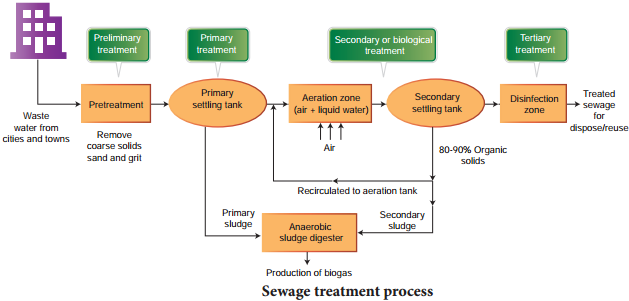Learninsta presents the core concepts of Biology with high-quality research papers and topical review articles.
Eutrophication | Definition, Types, Causes, & Effects
When run-off from land containing nutrients reaches water bodies like lakes, it results in dense growth of plant life. This phenomenon is called Eutrophication. Natural aging of lakes also leads to nutrient enrichment of its water.
In a lake, the water is cold and clear (oligotrophic stage), supporting little life. With time, streams draining into the lake introduce nutrients such as nitrates and phosphates, which encourage the growth of aquatic organisms. Aquatic plants and animal life grow rapidly, and organic remains begin to be deposited on the lake bottom (mesotrophic stage) (Fig. 12.5).

Pollutants from anthropogenic activities like effluents from the industries and homes can radically accelerate the aging process. This phenomenon is known as Cultural or Accelerated Eutrophication.
Nutrients stimulate the growth of algae, water hyacinth and can cause clogging of canals, rivers and lakes as well as, displacing native plants. It causes unsightly foam and unpleasant odours, and deprives the water of dissolved oxygen.
Integrated Wastewater Management
Wastewater Treatment
Wastewater or sewage originates from domestic waste waters, industrial wastes and animal wastes. Realizing the importance of clean potable water, the Government passed the Water (Prevention and Control of Pollution) Act in 1974, which made it mandatory to treat wastewater in treatment plants. The main objective of a wastewater treatment process is to reduce organic and inorganic components in wastewater to a level that it no longer supports microbial growth and to eliminate other potentially toxic materials.
Microorganisms mainly bacteria and some protozoa play an essential part in the treatment of sewage to make it harmless. Sewage contains pathogenic bacteria. These bacteria must be destroyed in order to prevent the spread of diseases. Sewage treatment is usually performed in the following three stages (Fig. 12.6).

Primary treatment
Primary treatment involves the physical removal of solid and particulate organic and inorganic materials from the sewage through filtration and sedimentation. Floating debris is removed by sequential filtration. Then the grit (soil and small pebbles) are removed by sedimentation. All solids that settle form the primary sludge and the supernatant forms the effluent. The effluent from the primary settling tank is taken for secondary treatment.
Secondary treatment or biological treatment
The primary effluent is passed into large aeration tanks where it is constantly agitated mechanically and air is pumped into it. This allows vigorous growth of useful aerobic microbes into floc (masses of bacteria associated with fungal fiaments to form mesh like structures).
While growing, these microbes consume the major part of the organic matter in the effluent. This significantly reduces the BOD (Biochemical oxygen demand or Biological oxygen demand). BOD refers to the amount of the oxygen that would be consumed, if all the organic matter in one litre of water were oxidized by bacteria. The sewage water is treated till the BOD is reduced. The greater the BOD of the waste water more is its polluting potential.
Once the BOD of sewage water is reduced signifiantly, the effluent is then passed into a settling tank where the bacterial “flocs” are allowed to sediment. This sediment is called activated sludge. A small part of activated sludge is pumped back into the aeration tank to serve as the inoculum. The remaining major part of the sludge is pumped into large tanks called anaerobic sludge digesters. Here, the bacteria which grow anaerobically, digest the bacteria and the fungi in the sludge. During this digestion, bacteria produce a mixture of gases such as methane, hydrogen sulphide and CO2. These gases form biogas and can be used as a source of energy.
Tertiary treatment
Tertiary treatment is the final process that improves the quality of the waste water before it is reused, recycled or released into natural water bodies. This treatment removes the remaining inorganic compounds and substances, such as nitrogen and phosphorus.
UV is an ideal disinfectant for wastewater since it does not alter the water quality – except for inactivating microorganisms. UV is a chemicalfree process that can completely replace the existing chlorination system and also inactivates chlorine-resistant microorganisms like Cryptosporidium and Giardia.
Case Study:
Auroville, located in South India near Puducherry has been experimenting with natural wastewater recycling systems (Decentralized Waste Water Treatment System (DEWATS)) (Fig.12.7a). Such treatment plants have now also been implemented in Aravind Eye Hospital, Puducherry (Root Zone Wastewater Treatment (RZWT)) (Fig.12.7 b) and the Chennai Mathematical Institute, Siruseri IT Park, Chennai.
